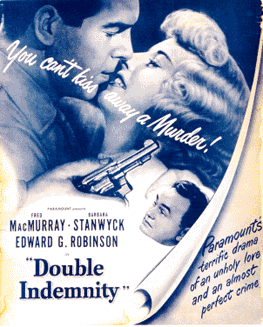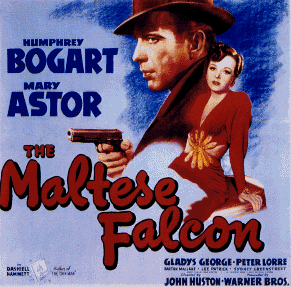Double Indemnity (1944) Billy Wilder
Double Indemnity is a classic example of a Film Noir as it features the typical storyline of a Hero, who is an insurance salesman, falling for the Femme Fatale who leads him to kill her husband to claim insurance money until it leads to their downfall. In this case there is a "double indemnity clause" in his insurance contract which pays out double, they go for this however it doesn't work out and the Hero shoots the Femme Fatale and he is caught out after a gunshot wound stops him from fleeing.
Early on in the film it is evident that the Femme Fatale seduces the Hero such as in the opening shot of the two meeting, it is a low-angle shot looking up at the Femme Fatale already showing she is superior. Also at the beginning of the film, the Femme Fatale wears an anklet that the Hero is seduced by which suggests she has already "captured" him.

After they kill the Femme Fatale's husband there is a downbeat atmosphere and they both seem depressed, this is what leads the Hero to confess he killed the husband to the insurance firm. During or after a depressing scene it is raining, this makes the viewer feel more of an effect. In the end we find out that the Femme Fatale was using the Hero all along and that she never loved him but just wanted the insurance money.

The film features a lot of single-source lighting, this casts deep shadows which is typical of a Film Noir. Sound is used in different ways such as when the husband signs the accident insurance forms there are slow, loud drums, used to create an impact. Also the music gets faster in some scenes to build tension, typical of any film.
Throughout the film it is evident that the couple will never get away with what they have done. Every time they think something is going their way another thing happens that could get them caught. Example of this include; the Femme Fatale's step-daughter finding out what happened to her mum and the black hat she saw her trying on, Keyes and his many "hunches" and Jackson saying it wasn't the Femme Fatale's husband on the train.





















